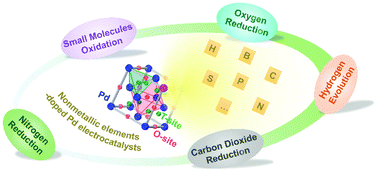Emerging interstitial/substitutional modification of Pd-based nanomaterials with nonmetallic elements for electrocatalytic applications
Abstract
Palladium (Pd)-based nanomaterials have been identified as potential candidates for various types of electrocatalytic reaction, but most of them typically exhibit unsatisfactory performances. Recently, extensive theoretical and experimental studies have demonstrated that the interstitial/substitutional modification of Pd-based nanomaterials with nonmetallic atoms (H, B, C, N, P, S) has a significant impact on their electronic structure and thus leads to the rapid development of one kind of promising catalyst for various electrochemical reactions. Considering the remarkable progress in this area, we highlight the most recent progress regarding the innovative synthesis and advanced characterization methods of nonmetallic atom-doped Pd-based nanomaterials and provide insights into their electrochemical applications. What's more, the unique structure- and component-dependent electrochemical performance and the underlying mechanisms are also discussed. Furthermore, a brief conclusion about the recent progress achieved in this field as well as future perspectives and challenges are provided.

- This article is part of the themed collection: Recent Review Articles


 Please wait while we load your content...
Please wait while we load your content...